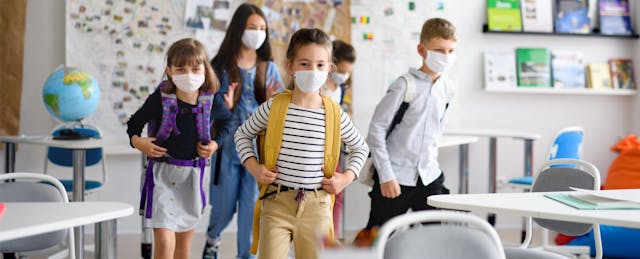When students returned to the classroom after COVID-19 lockdowns, teachers found themselves in a triple role: instructor, mental health proctor and public health enforcer.
There have been plenty of adjustments to the classroom due to continued health precautions, and that has meant differences in what school supplies are needed.
It’s the little things, like crayons, says Christine Slayton, a bilingual first grade teacher at Frank Del Olmo Elementary School in Los Angeles. No more sharing Crayolas—or markers or playdough. Now each student needs their own.
These challenges have put a strain on teachers, who’ve had to both engage kids while keeping them safe and search the coffers for money for extra materials or to help kids recover lost social and emotional skills.
For many teachers, the answer has been crowdfunding.
While school districts wrestle with spending COVID relief funds amid staff shortages and supply chain issues, there often aren't readily available funds for projects that teachers feel increase their student’s mental health and their ability to transition back to school.
Across the country, 87 percent of U.S. public school districts have at least one teacher who has posted a project on DonorsChoose, a nonprofit crowdfunding platform for educators. Those online pleas for resources have raised $1.27 billion since 2000, according to impact data from DonorsChoose’s site. That’s even though some school districts, like Metro Nashville Public Schools, have previously banned their teachers from using the crowdfunding site, out of concern over lack of oversight of how the funds are used.
Although the number of teachers using the site dropped with the first year of the pandemic while many school buildings were shuttered, use of the site has picked up since last spring with the return to classrooms, according to Abby Feuer, DonorsChoose’s executive vice president of marketing and growth.

The data shows that teachers have been asking for donations that will cover a broad range of student’s needs, especially ones related to health.
Perhaps unsurprisingly, health and wellness requests were up for both years of the pandemic, with 18,361 such requests from 2021-2022. Most of those projects are for things like furniture which are meant to create a calming space for students, Feuer says. That wasn't the only increase: Warmth, care and hunger requests increased 25 percent during both the first and the second years of the pandemic, with 8,421 requests from 2020-2021 and 11,332 requests from 2021-2022.
But the biggest change was in food, clothing and hygiene requests, which DonorsChoose groups with social and emotional learning. During the second year of the pandemic, from 2021-2022, there were 19,027 requests in that category, a 52 percent increase.
Mental health
As students returned to the classroom, a larger share of students needed social-emotional learning and mental health attention, says Sherri Jackson, a seventh grade special education teacher for KIPP All Middle School in the Bronx. Even the students who would normally perform well were struggling. “That was really a red flag,” she says.
Suddenly, her role had changed, teaching kids the skills they need to navigate a classroom—to hone their ability to self-regulate and to think positive. “Now, that’s more on my plate, instead of just teaching,” she says.
While the school covers basic needs, Jackson turned to online crowdfunding for resources to tackle these additional needs for her students.
“I’ve been focusing more on student’s mental health and social and emotional learning,” she says.
She set up a “self-care” library where students can go to read if they’re having a bad day or need inspiration, which helps the students using it and can reduce disruption to the class.
It has been a time of so much change, but the kids are making that adjustment now, Slayton of Frank Del Olmo Elementary School says. “You can see the kids are a little bit more playful, a little bit more excited to be at school.”
Other teachers, though, have suggested that the need to use crowdfunding reflects the lack of support for teachers across the country—part of what has left many teachers feeling demoralized.
Daniel Mollenkamp is a business reporter at EdSurge. Reach him at daniel@edsurge.com.


